Grease trap for washing: operating principle, types of structures and features of their installation
A clogged sewer pipe in a kitchen is common. Food debris, fat deposits accumulate on the walls of the channel and prevent the free outflow of water. To clean the pipes you have to use chemicals that harm plumbing fixtures, or resort to mechanical methods - use a cable or plunger.
It is quite possible to reduce the likelihood of clogging by putting a grease trap under the sink - the device filters the effluents and prevents the grease from seeping deep into the sewers. The unit is quite useful, but before deciding to buy it, you need to learn more about such a separator, agree?
The article describes in detail the device, characteristics, principle of operation and modification of grease traps. It also provides recommendations for the selection of the device, its installation and maintenance.
The content of the article:
Types of grease traps for washing
There are a lot of types of grease traps, and all of them have different performance and equipment. This equipment can be classified by case material and design features.
Grease traps can be plastic, fiberglass, metal.
Plastic Both industrial and the simplest household models of grease traps are made from polypropylene and polyethylene.They are durable, cheap, lightweight and require no special maintenance. Most grease traps for washing are made of this material.
Fiberglass. These models have increased strength and resistance to chemicals, so they can be installed outdoors and dig into the ground.
Metal. Stainless steel grease traps can be easily washed with stiff brushes without fear of damaging the surface. They look aesthetically pleasing, but are not cheap. Models made of stainless steel and aluminum are almost eternal, unlike products made of galvanized and painted steel, which can rust over time.

Separators in private houses can be made independently, and there are not so many structural requirements for them, so there are countless options for the execution of this equipment.
However, they can still be divided into the following types:
- Grease traps under the sink. They will be considered in detail below. Such equipment is serviced manually and installed in apartments, houses, small cafes.
- Industrial (workshop) models. They are used in catering facilities designed for hundreds of people, in boarding houses and sanatoriums, as well as in food industry enterprises. Often, such models are equipped with fill sensors.
- Automatic. They have an electromechanical mechanism for the collection of fat, which facilitates maintenance and prevents clogging of the supply and outlet pipes.
- Located below the sewage level. Such models are installed in the basement or in the ground. They have a built-in electric pump that pumps purified water to the level of sewage.
- Well. These are large industrial grease traps in the form of a cylinder, which can be installed in special outdoor wells. Their service is carried out through the hatch.
For domestic needs, it is enough to purchase a conventional grease trap for washing, which you can service yourself once every few weeks. These small devices have a simple design and device.
Grease trap specifications
To choose a separator that will enter the space under the sink, you need to know not only its overall dimensions and structure, but also its functionality. The individual characteristics of the apartment and the nature of the nutrition of its residents are of considerable importance when choosing an apparatus.
The scheme of the device and the principle of operation
Household drains from the kitchen sink contain a lot of fat, which gradually settles in sewer pipes. After a few years, this can lead to clogging of the pipeline, the appearance of a persistent unpleasant odor from the decomposition of organic matter and the need sewage flushing.
Old fat deposits are poorly recovered even plumbing cable, therefore, to remove them, you may need to completely dismantle the sewer system.
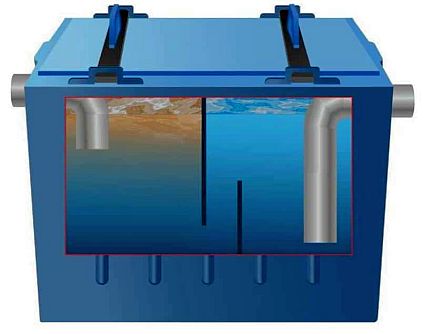
These problems can be solved by installing a grease trap under the sink.
Such equipment consists of the following elements:
- Rectangular housing with two openings (inlet and outlet) located at opposite ends of the grease trap.
- One or more partitions. They slow down the flow of water in the system, preventing fat and particulate matter from entering the sewers.
- Tight-fitting lid. It should have a rubberized gasket so that air does not enter the kitchen from the interior of the grease trap.
- Inlet pipe in the form of a short knee.
- Exhaust pipe in the form of an open tee on all sides. It has a long part, lowered almost to the bottom of the body and a short, ending under the lid.
- Ventilation outlet (optional).
The design of the grease trap determines the principle of its operation. Contaminated water enters the intake chamber of the grease trap. The entrance can be either side or top. This part of the space is fenced off with one or two partitions. Due to the difference in the density of water and fat, the latter rise up and accumulate there.
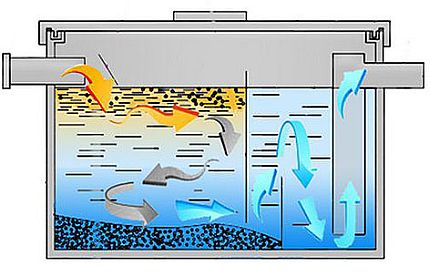
If the wall is one, then it usually overlaps the lower 2/3 of the cross-section of the grease trap, and if there are two, then they are located alternately from the bottom and from the top: the first cuts off solid particles, and the second cuts off fat.
Behind the partitions there is a second chamber, from the lower part of which water that is already cleared of grease and impurities is discharged to the sewer.
The fat fraction gradually fills the upper part of the internal space of the device, therefore it is necessary to clean it in a timely manner, without waiting for the moment when the accumulated fats begin to fall into the discharge pipe.
Formulas for calculating the required performance
Hoping that the smallest grease trap will be enough for an apartment is not worth it. It is better to calculate in advance the required performance of the equipment, so that later you do not regret the wasted money.
For the calculation, a simple formula is used:
P = n * Ps,
Where:
- R - productivity in liters per second;
- n - the number of connected sinks;
- Ps - the rate of flow of water into the separator in liters per second.
Ps can be calculated independently using a bucket or pan with a known volume. To do this, you must fully open the water tap and notice the time for which the tank is typed. Then calculate how much water will flow out if the tap is opened for one second.
The calculation is performed according to the formula:
Ps = V / T,
Where:
- T - time of water intake into the tank in seconds;
- V - the volume of capacity in liters.
After determining the required performance of the grease trap, you can also find out its recommended volume.
Volume calculation formula:
V = 60 * P * t,
Wheret - the rate of emergence of fat, the value of which for household separators is equal to 6.4 minutes

Grease traps for washing are available on the market with a capacity of 0.145 l / s and a volume of 50 l or more. The smaller capacity of the device simply does not physically allow it to effectively perform the functions of cutting off fat, so there is no point in acquiring such models.
Separator Performance Requirements
When operating the grease trap, it is necessary to observe a number of rules that increase the efficiency of the equipment and help to avoid unpleasant odors and flooding in the kitchen.
Recommendations for the use of the device:
- Water effluents should not contain mineral and synthetic oils.
- It is not permissible to connect the grease trap to the toilet.
- Pumps must not be installed in front of the equipment because they form a poorly deposited emulsion.
- Inlet pipes should be as close as possible to the sink and have a minimum slope of 2 ° C.
- Treated water must be sent directly to the sewer.
- It is advisable to connect the grease trap to the ventilation - fan pipeif the cover of the device has a corresponding outlet.
To produce quality products, manufacturers must adhere to the standards for the manufacture and installation of grease traps EN 1825 and DIN 4040-100. Access to the texts of these standards is within $ 100.
What are good grease traps
Although the volume of the fat separator for wastewater is small, in apartments it occupies a whole section of the cabinet under the sink. Therefore, there must be good reasons for installing such equipment.

Grease trap owners note their advantages:
- Simplicity of construction. You can assemble the separator yourself from the old plastic tank.
- Easy installation. To connect the device to a siphon and sewage system, simply connect the two pipes by hand without using a tool.
- Ease of maintenance. Take the upper fat once every few weeks. The cleaning process takes 2-3 minutes.
- Pipe clogging protection. When using a grease trap, the sewage system will last more than one decade without the need for cleaning.
- Compactness and the ability to install equipment under the sink.
The grease trap can be connected to the grease trap.
The main task of the grease trap is not the general purification of water, but the separation of particles from it, which can settle in sewer pipes and narrow their lumen.
How to choose a home appliance
The initial stage of the selection of the grease trap is carried out not in a hardware store or on the Internet, but in the planned place of its installation. Before buying a device, you need to decide on a number of parameters that will help narrow down your choices to several models.
First of all, it is worth evaluating:
- Free space under the sink. Please note that there must be space on top for removing the cover, and on the sides for connecting pipes.
- Diameter of sewer pipes in the kitchen. It is better to buy a grease trap with a similar hole size so as not to use additional plastic adapters.
- Number of served sinks. When calculating the productivity, it is necessary to take into account the simultaneous flow of effluents from all open taps.
- Characteristics of drains. With a large amount of solid particles in the drained water, it is recommended to install models of grease traps with several partitions.
- The presence of a sewer riser or fan pipe near the sink - a channel is necessary to prevent a breakdown siphon water trap. Air duct models are preferred, but not every apartment or house has the ability to connect them to the sewer riser.
- Space availability for equipment maintenance work. When fat is removed, waste with an unpleasant odor can fall outside the housing of the grease trap, so it should be possible to clean this space
- Body material. For installation under the sink, an ordinary plastic grease trap will be enough, but if it is open for viewing, you can buy a more expensive and aesthetic model in stainless steel.
- Washing volume. Sometimes it is required in one gulp to dump water from a fully typed sink. This amount of liquid is one of the characteristics of the grease trap and must be indicated in the instructions.
After taking into account all the above nuances, you can proceed to the direct selection of a suitable device from the options offered on the market.
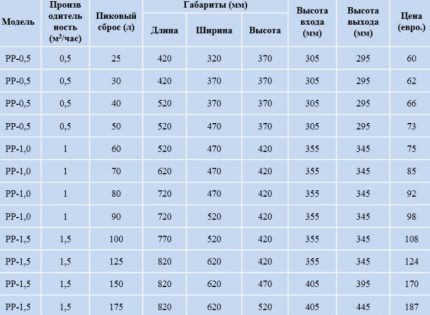
The price of plastic models depends mainly on the volume of the tank and the complexity of the internal device. With the same parameters, it is better to choose the cheaper option, because a more expensive model is unlikely to be of better quality.
Installing the grease trap under the sink
Installing a grease trap under the sink does not require any special skills or tools. All necessary connecting parts can be purchased in the same store where the device itself is purchased. Additional polypropylene fittings and tubes may be needed only to connect the grease trap to the sewer and siphon.
The separator is usually sold in assembled condition, that is, connecting pipes or rubber adapters are already inserted and sealed in its openings. It remains only to open the lid and remove the operating instructions from the tank.
After this, the final installation of the grease trap can be carried out:
- Prepare the workspace under the sink.
- In some models of equipment, the elbow for the intake of water and the tee for its drain are attached separately, so they must be inserted into the corresponding holes, previously lubricated with silicone.
- Screw adapters to the separator if necessary.
- Place the grease trap under the sink.
- Grease outside plumbing sealant sewer and siphon nozzles that will connect to the grease trap.
- Connect all necessary pipes to the separator and wait for the sealant to solidify.
- Connect the duct to the sewer riser, if any.
- Open the tap with water and check the tightness of the tank and pipe connections.
If there are no leaks, then the grease trap is ready for operation.
Since the efficiency of the grease trap is greatly influenced by the temperature of the water, it is undesirable to install it next to the actively used oven. It is also required to protect the separator from exposure to negative temperatures in the presence of water in it, as this can lead to rupture of the tank.
Separator service and control
Maintenance of the grease trap is not the most pleasant procedure, but it is much more unpleasant to clean the clogged sewer pipes.
The frequency of cleaning a household separator depends on several parameters:
- grease trap tank volume;
- family diet, determining the composition of drains;
- temperature of water used.
Due to these factors, the frequency of cleaning the separator can range from several weeks to several months.
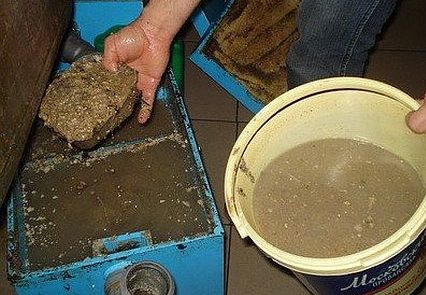
Close attention to the level of effluents must be given in the first weeks of operation. Periodically open the grease trap cover and check the level of solid waste. If the lower layer of fat drops to the level of the outlet, then it may become clogged, which will lead to overfilling of the tank and flooding of the room.
It is advisable to remove the fat mass at the time it reaches a level 4-5 cm above the lower edge of the water-discharge pipe. To remove grease, you need to open the tank cap and pull out the upper viscous layer with gloves, a bucket or other improvised device.
After revising the grease trap, you can rinse it with hot water for several minutes.
When the approximate period of safe operation of the grease trap has already been established experimentally, you can look into it much less often.
More information about the different types of grease traps for sewage, an overview of popular models, as well as the specifics of installing the separator inside and outside the premises are described in this article.
Conclusions and useful video on the topic
For a better understanding of the internal structure of the grease trap, the features of its operation, the installation and maintenance rules, it is recommended to watch the videos below. They will summarize the knowledge gained and allow you to see the operation of the device in dynamics.
Mounting the grease trap under the sink:
Grease trap operation:
Cleaning the separator from grease:
The purchase and installation of a grease trap under the sink helps to avoid a lot of problems with a clogged sewer. To install the equipment, it is enough to have free space under the sink, because the process of putting the separator into operation is simple and does not require much time.
Looking for an efficient grease trap for a kitchen sink? Or have experience using such installations? Please leave comments on the article and share your impressions about the use of grease traps. The contact form is located in the lower block.

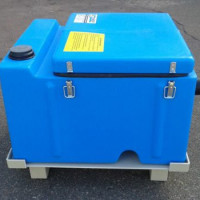 Grease traps for sewers: types, selection rules + installation procedure
Grease traps for sewers: types, selection rules + installation procedure  Cast iron pipes for outdoor sewage: types, features of application and installation
Cast iron pipes for outdoor sewage: types, features of application and installation 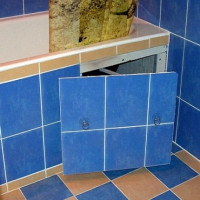 Inspection hatches for tiles: an overview of the best designs and options for their arrangement
Inspection hatches for tiles: an overview of the best designs and options for their arrangement 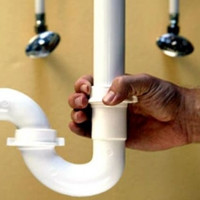 Water lock for sewerage: classification of water locks and the rules for its installation
Water lock for sewerage: classification of water locks and the rules for its installation  How to clean dry closets: features of cleaning peat and liquid varieties of dry closets
How to clean dry closets: features of cleaning peat and liquid varieties of dry closets  Fan pipe for the toilet: what is needed + nuances of installation and connection
Fan pipe for the toilet: what is needed + nuances of installation and connection  How much does it cost to connect gas to a private house: the price of organizing gas supply
How much does it cost to connect gas to a private house: the price of organizing gas supply  The best washing machines with dryer: model rating and customer tips
The best washing machines with dryer: model rating and customer tips  What is the color temperature of light and the nuances of choosing the temperature of the lamps to suit your needs
What is the color temperature of light and the nuances of choosing the temperature of the lamps to suit your needs  Replacement of a geyser in an apartment: replacement paperwork + basic norms and requirements
Replacement of a geyser in an apartment: replacement paperwork + basic norms and requirements
In my opinion, putting a grease trap at home, no matter in an apartment or in a private house, is stupid and wasteful. An ordinary siphon will cope with its function. But if you are preparing pies for sale, or boldly pour fat from the fryer directly into the sink, then yes, it is necessary.
But for catering, especially the street it is needed. In general, it is needed, as it seemed to me, wherever there is little water, poor sewage and there is the problem of the impossibility of dumping waste into separate containers.
Victor, this is really not necessary in apartments, but in some private houses you can’t do without a grease trap. My house is old, the sewer comes from the neighbors and gets clogged up instantly. Previously, it was necessary to call specialists every three months to clean, and after putting the grease trap, this happens a maximum of once every six months. It turns out a good saving.
Grease trap is a good thing. Excellent prevention, ensuring the normal operation of plumbing drains and sewer pipes. It should be used so that there are no blockages and the pipeline lumen does not overgrow with insoluble sediment.
My brother and I have a roadside cafe, the sanitary and epidemiological surveillance forces this fat trap to be installed. And most importantly, prices for such nonsense from 9-10 thousand start. They all profit.